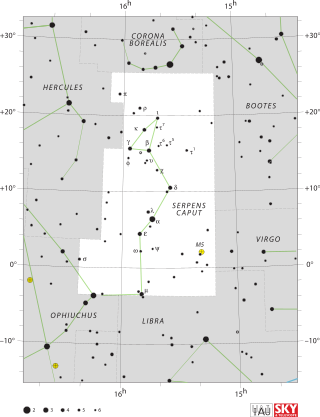Top Qs
Timeline
Chat
Perspective
Lambda Serpentis
Star in the constellation Serpens From Wikipedia, the free encyclopedia
Remove ads
Lambda Serpentis, Latinized from λ Serpentis, is a star in the constellation Serpens, in its head (Serpens Caput). It has an apparent visual magnitude of 4.43,[2] making it visible to the naked eye. Based upon parallax measurements, this star lies at a distance of about 38.9 light-years (11.9 parsecs) from Earth.[1] Lambda Serpentis is moving toward the Solar System with a radial velocity of 66.4 km s−1.[4] In about 166,000 years, this system will make its closest approach of the Sun at a distance of 7.371 ± 0.258 light-years (2.260 ± 0.079 parsecs), before moving away thereafter.[9]
This star is 36% larger and 9% more massive than the Sun, although it has a similar stellar classification. It is shining with nearly double the Sun's luminosity and this energy is being radiated from the star's outer atmosphere at an effective temperature of 5,901 K.[6] A periodicity of 1837 days (5.03 years) was suspected by Morbey & Griffith (1987),[10] but it is probably bound to stellar activity. However, McDonald Observatory team has set limits to the presence of one or more exoplanets[10] around Lambda Serpentis with masses between 0.16 and 2 Jupiter masses and average separations spanning between 0.05 and 5.2 Astronomical Units.
Remove ads
Planetary system
In 2020, a candidate planet was detected orbiting Lambda Serpentis (HD 141004). With a minimum mass of 0.043 MJ (13.6 M🜨) and an orbital period of 15 days, this would most likely be a hot Neptune.[11] The planet was confirmed in 2021.[12]
Remove ads
References
Further reading
Wikiwand - on
Seamless Wikipedia browsing. On steroids.
Remove ads

